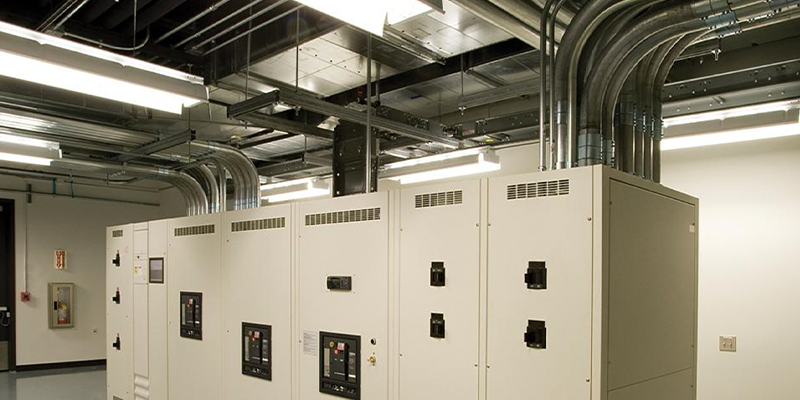
Up to this point, we have discussed electrical rooms and how the National Electrical Code® (NEC®)—specifically, 110.26—helps ensure there is enough space, especially working space, in those rooms or areas. In Part 2, we observed that changing the voltage alters some of the clearance requirements for the equipment in electrical rooms (see 110.32 and 110.34 of the NEC).
This is the last in a three-part series on electrical rooms. Read Part 1 here and Part 2 here. Working space about electrical equipment is covered in Article 110 of the NEC.
Now, we will look at an electrical enclosure, vault, or tunnel that is being used as a method for guarding electrical equipment and see how it affects clearances for working space about electrical equipment.
What is an electrical enclosure?
First, let’s look in Article 100 to see if there is a definition for a vault or tunnel. We find there isn’t one, but we do find a definition for enclosure. Enclosure is defined as “the case, housing of an apparatus, or the fence or walls surrounding an installation to prevent personnel from accidentally contacting energized parts, or to protect the equipment from physical damage.”
So, does this definition cover an electrical room or vault? I think it could, because the vaults are areas typically surrounded by walls and frequently some form of lockable entrance.
Does a vault or enclosure still require working space for electrical equipment? Yes, Parts II and III of Article 110 cover these requirements. For voltages of 50 to 1000 volts, nominal, 110.27(A)(1) would address the use of a room, vault, or similar enclosure that is accessible only to qualified persons, as a means of protection against accidental contact with live parts. For the over 1000 volts, nominal, installations, 110.31(A)—which deals with electrical vaults, including their construction requirements—would apply.
Often, we see vaults being utilized as electrical rooms for installations over 1000 volts versus the under-1000-volt installations. This is in part due to electrical installations using exposed terminations or the use of larger substations and switches, which could increase the risk of accidental contact with live parts, depending on the type of equipment.
Construction of enclosures
Construction of the vault roof and walls must not be made from studs or wall board, but instead from construction materials that will provide adequate structural strength for the conditions and possess at minimum a 3-hour fire rating. This is usually accomplished using materials that are made from or contain concrete, like a masonry block wall with pre-cast concrete planks for the roof and floor, or a complete pre-cast concrete unit. Where the floor is in contact with earth it must not be less than 4-inch-thick concrete. However, where vacant space or stories are below the floor, it may need to be engineered to be able to structurally withstand the loads imposed on the floor.
A vault will normally have access doors as well, which are required to be tight-fitting and have a 3-hour fire rating, unless the vault has an approved fire suppression system installed, in which case the doors can be 1-hour fire rated. These doors must also be lockable, to restrict access to unqualified persons. To allow safe egress in the event of an electrical injury, the doors must be equipped with panic hardware and open 90 degrees in the direction of egress. Don’t forget the signage that must be on the doors (See Part 2 in this blog series for more on signage). Should an electrical catastrophic failure occur, the vault’s robust construction will help mitigate damage to other portions of the building, which could ultimately save lives.
This type of heavy-duty construction requires detailed planning from the electrical contractor and design professional for all electrical equipment locations and the penetrations into the vault from feeders, branch circuits, or raceways that will be connecting to that electrical equipment. These penetrations must not reduce the rating of the vault.
The electrical equipment contained in the vault, such as the switchgear, transformers/substations, and motor control centers (MCC), must meet the working space requirements found in 110.26, 110.32, and 110.34 of the NEC. The applicable NEC section is determined by the highest nominal voltage for the equipment in a particular area, since there may be more than one voltage within a vault. Where high-voltage equipment is contained within the same vault as equipment 1000 volts or less, there may need to be some separation in accordance with 110.34(B). If the separation is accomplished with a fence controlled by locks, then 110.31 would apply. Table 110.31 contains distance values for the required space between the equipment and the separating fence. Note that the fence cannot be within the working space measurements found in Table 110.34(A).
Adding electrical equipment in a vault does not reduce the working space requirements found in 110.26 or 110.34. It just adds some additional items to work around. Whether your electrical equipment is in an electrical room or a vault, you must maintain proper clearances for worker safety.
A great way to learn more about working space about electrical equipment is to register for the NFPA online training series on the 2023 edition of the NEC. Working space about electrical equipment is covered in the General Equipment Installation Practices section of this training. Learn more about this comprehensive, self-paced training.
Important Notice: Any opinion expressed in this column (blog, article) is the opinion of the author and does not necessarily represent the official position of NFPA or its Technical Committees. In addition, this piece is neither intended, nor should it be relied upon, to provide professional consultation or services.
The post "Electrical Room Basics, Part 3" appeared first on NFPA Today Blogs







0 Comments